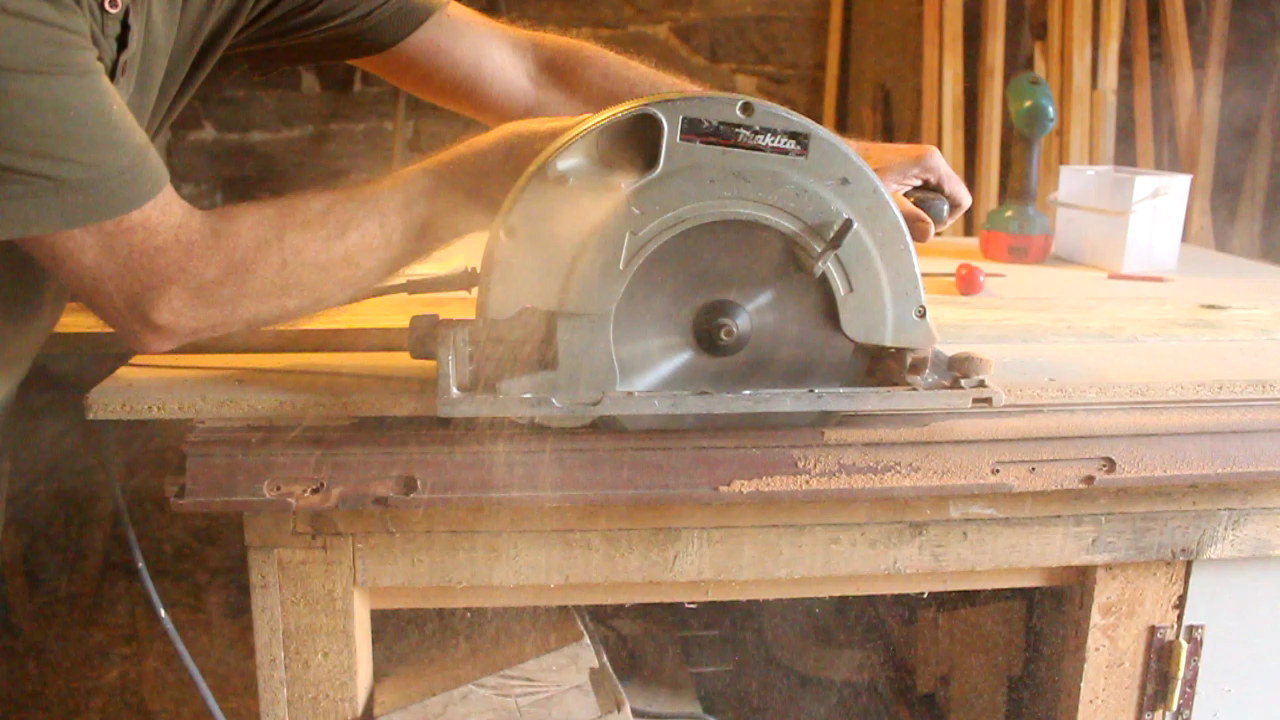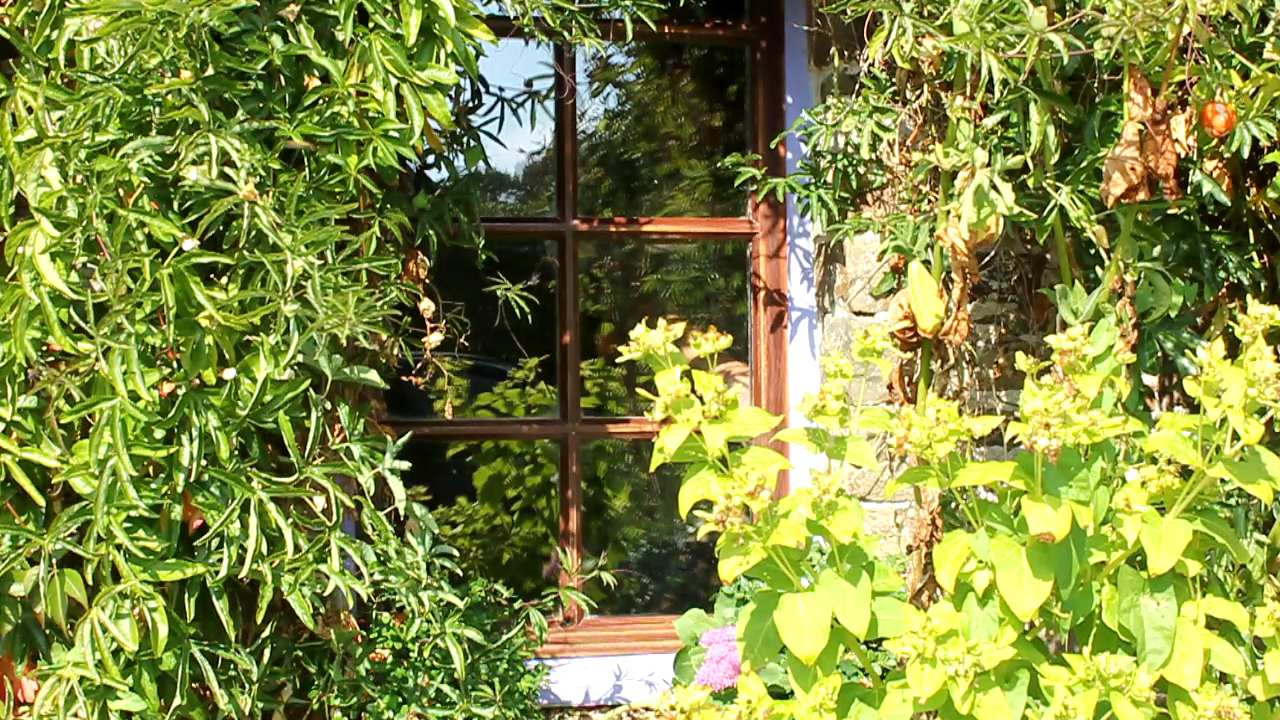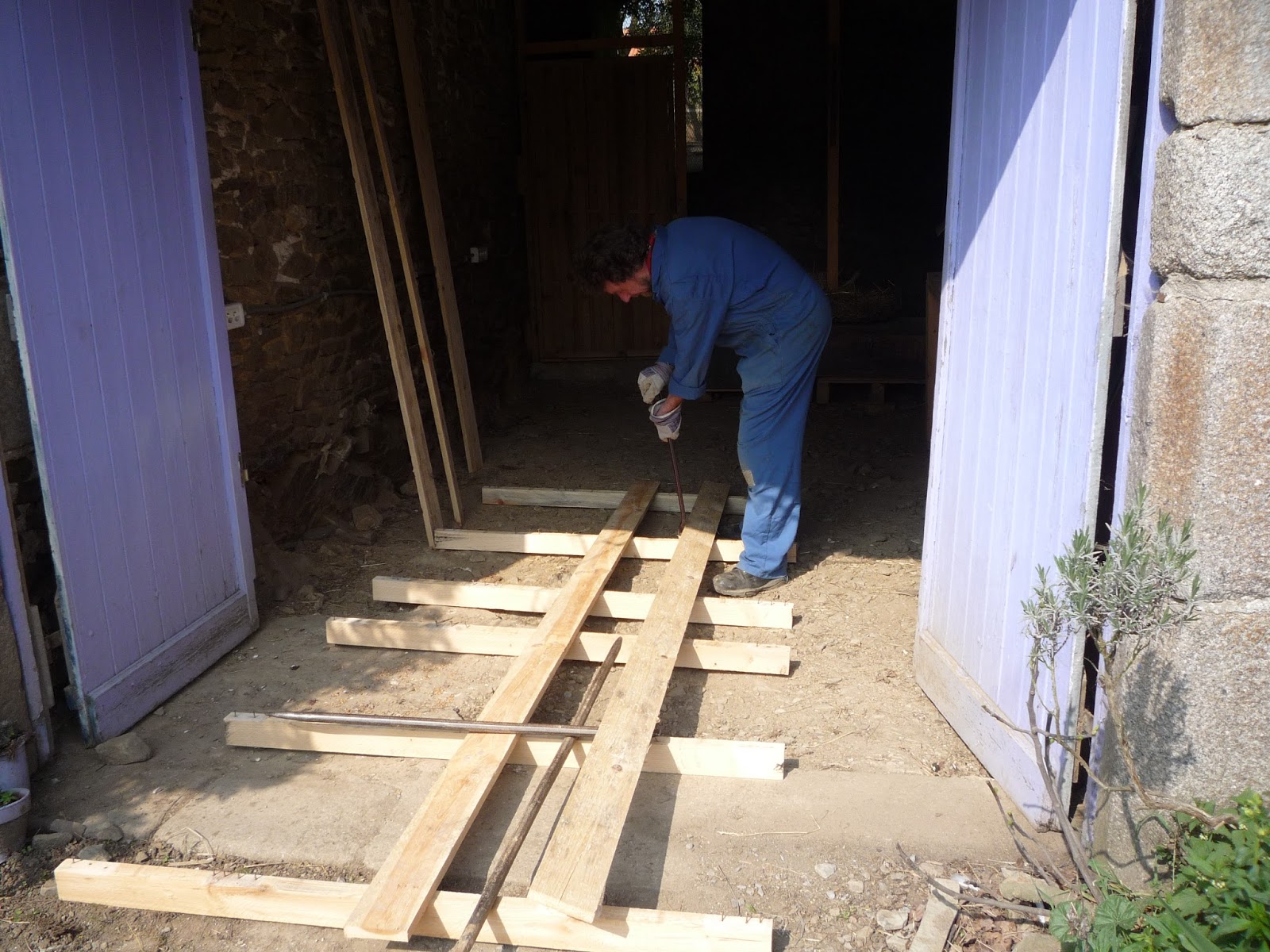Our house, a vernacular longère was never meant to have glass windows and as it had rarely been lived in during the hundred years before we bought it, that aspect had hardly changed. When we came to think about glazing, we decided use the vast amount of discarded windows available. Luckily there was so much raw material, we found a near match for just about every opening. Below is the raw state of our sitting room (middle of photograph), just a few years after the sheep vacated it. As if to add insult to injury and coincidentally a few months before we came out to start living in our house permanently and begin the renovations, hurricane Lothar hit.
Our ruined ruin
Nowadays, we tend to forget and thus to appreciate the value of glass windows, which is probably why people are so ready to replace perfectly good ones and dump them. In past centuries, even the nobility could afford only one set of such precious materials and would ferry them between homes as they moved from Town to Country and back again. The farm where Sue was born had one big picture window bricked up to a tiny 'porthole', due to Window Tax, a stark reminder that even daylight can be subject to payment.
Introduction
There is a previous post which covers the recuperation of old windows, where and how to find them - it can be found here
In this post I am going to start with the first of my three window projects for this Autumn, the easiest one, replacing an existent recuperated window (above left).
In this post I am going to start with the first of my three window projects for this Autumn, the easiest one, replacing an existent recuperated window (above left).
We luckily recuperated a pair of these double-glazed units some ten years ago and I made a frame for and fitted one of them into our sitting room. In the past few months this window has began to look foggy or 'sick' as the seal between the two layers of glass had started to deteriorate.
Method
All
double-glazed windows have a frame with an elaborate profile to ensure a
watertight, draught proof joint.
The frame for the window was made using softwood (pine) and if I remember correctly was cut from floor joist wood left over from when we put floors in this part of the house. The wood selected was as thick as the window. On completion the outside face of the window rested against a rebate cut into the frame. The interior face of the window had a 'lip' 10mm thick on 3 edges (top, bottom and latch) which butted against the frame. The lip extended 10mm from the window edge thus, the interior height of the window was 20mm more than the exterior height. The fourth (hinge) edge of the window was not originally cut square but was cut at an angle (inset above). I could not hope to achieve this when making the frame, so, after removing the hinges, I cut out the angle and made this edge the same as the top and bottom and made the frame to match.
The profile on the latch side of the window (the one opposite the hinges) was slightly more elaborate in that it had a stepped profile to accommodate the latch mechanism and a rubber seal running the full window height. This meant that in forming this part of the frame I had to make two additional cuts with the circular saw to produce the matching profile.
Throughout the the life of this window I have never detected any draught so consider the fit was more than adequate.
The desired cut was 10mm less than the full depth of the wood so as to ultimately furnish a lip that would match those on the other three sides of the window.
In my workshop I do not have a saw table but I do have an excellent circular saw. So, whenever possible, I do not use the guide on the saw but use a clamped straight edge against which the baseplate of the saw can slide. In the case of the window I also lacked a surface upon which the saw could move. So, to furnish this I screwed a flat piece of chipboard (recuperated from a pallet top) to the uppermost (inside) face of the window. It is to this surface that I screwed the straight edge to act as the saw guide (below). The second and equally important point about using the chipboard is that prudent packing beneath it brought its upper-face level with the stool (the projecting profile that sheds rain water onto the sill) so that the depth of the saw cut remained constant. You can see the packing in the picture above and below (I used 10mm thick pieces of cladding wood).
NOTE
When I unscrewed the hinges I had two screws that sheared off in the frame, these I then had to drill out so as not to damage the circular saw blade, maybe I should have put a few drops of release oil on the screws prior to trying to get them out.
The frame for the window was made using softwood (pine) and if I remember correctly was cut from floor joist wood left over from when we put floors in this part of the house. The wood selected was as thick as the window. On completion the outside face of the window rested against a rebate cut into the frame. The interior face of the window had a 'lip' 10mm thick on 3 edges (top, bottom and latch) which butted against the frame. The lip extended 10mm from the window edge thus, the interior height of the window was 20mm more than the exterior height. The fourth (hinge) edge of the window was not originally cut square but was cut at an angle (inset above). I could not hope to achieve this when making the frame, so, after removing the hinges, I cut out the angle and made this edge the same as the top and bottom and made the frame to match.
The profile on the latch side of the window (the one opposite the hinges) was slightly more elaborate in that it had a stepped profile to accommodate the latch mechanism and a rubber seal running the full window height. This meant that in forming this part of the frame I had to make two additional cuts with the circular saw to produce the matching profile.
Throughout the the life of this window I have never detected any draught so consider the fit was more than adequate.
Thus with the replacement, after the overall
dimensions were found to match the old unit, the hinges were removed. In the following photographs you can see the steps I took to cut the edge square using a circular saw.
The desired cut was 10mm less than the full depth of the wood so as to ultimately furnish a lip that would match those on the other three sides of the window.
In my workshop I do not have a saw table but I do have an excellent circular saw. So, whenever possible, I do not use the guide on the saw but use a clamped straight edge against which the baseplate of the saw can slide. In the case of the window I also lacked a surface upon which the saw could move. So, to furnish this I screwed a flat piece of chipboard (recuperated from a pallet top) to the uppermost (inside) face of the window. It is to this surface that I screwed the straight edge to act as the saw guide (below). The second and equally important point about using the chipboard is that prudent packing beneath it brought its upper-face level with the stool (the projecting profile that sheds rain water onto the sill) so that the depth of the saw cut remained constant. You can see the packing in the picture above and below (I used 10mm thick pieces of cladding wood).
NOTE
When I unscrewed the hinges I had two screws that sheared off in the frame, these I then had to drill out so as not to damage the circular saw blade, maybe I should have put a few drops of release oil on the screws prior to trying to get them out.
In making the second cut to produce the lip, the guide and chipboard were unscrewed and the window placed on the floor, held vertically by clamping one end between the jaws of a 'Workmate'.
I clamped a flat piece of timber along the window edge to provide additional support for the saw so as to help maintain the 90º cut along the length. The depth of the cut was set so as to intersect the bottom of the first cut.
Once the cut had been made I was left with the desired square cut edge except that the lip produced was slightly too long, This lip length was important as this is the where the hinges are mounted.
Laying the window back onto the workbench I screwed the straight edge to the uppermost face so as to guide the saw in its third and final cut.
The existing window was hung on screw-in barrel type hinges and as they were in a perfect condition, I intended to use them again. I obviously had not removed the one half of the hinges from the window-frame so I needed to remove the other half from the old window and screw them into pre-drilled holes in the replacement.
To ensure the holes were drilled vertically into the edge (of the lip), I rested the window on a pallet which was made to be parallel to the workbench top, the window resting against the leg of the workbench. I used a try-square to check that the window was at right angles to the workbench top and used wood packing between the window and leg to achieve this. Once all was checked OK for being square I drilled pilot holes at the pre-marked positions using the small drill press on the top of the workbench, thus ensuring the hole was square going into the 10mm thick lip of the window.
I next opened up the holes by drilling once again but with a larger bit, the pilot holes ensuring the bit did not ‘wander’.
When
I had finished drilling, I tried the window in place to ensure the fit
was good.
Once done, I could remove it and insert the hinges. The hinges had an M6 thread and I have found with exotic hard woods that by running the matching tap into the holes it makes it much easier to screw the hinges in.
Once done, I could remove it and insert the hinges. The hinges had an M6 thread and I have found with exotic hard woods that by running the matching tap into the holes it makes it much easier to screw the hinges in.
What
was then required was to lift the new window onto the hinge
counterparts in the window frame, again some adjustment was necessary to
ensure exact alignment with each hinge. This can be the most
time-consuming part of the operation as it may require the screwing in
or out of each hinge until the precise alignment is obtained.

When the window was satisfactorily mounted. I could check that it still fitted in the frame, some slight sanding was required and that the closing mechanism also engaged with the existing holes in the frame.
Et Voilà! - a new window!
Now if you'd like to, sit back and watch the film:
Thanks for dropping by and please feel free to share this article, comment, ask questions and if you'd like to be assured of getting the next post, then sign up to follow this blog.
All the best, Andy
© Andy Colley 2014



























































